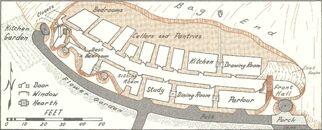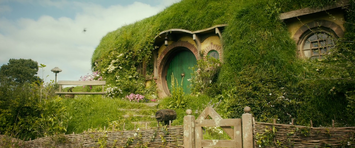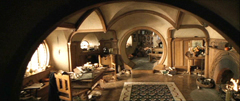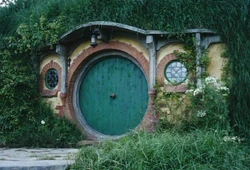- "In a hole in the ground there lived a Hobbit. Not a nasty, dirty, wet hole, filled with the ends of worms and an oozy smell, nor yet a dry, bare, sandy hole with nothing in it to sit down on or to eat: it was a Hobbit-hole, and that means comfort."
- —Opening sentence of The Hobbit, "An Unexpected Party"
Bag End, or Bag-End, was a smial situated at the end of Bagshot Row in Hobbiton. It was the home of Bilbo Baggins, afterwards of Frodo Baggins, and later of Samwise Gamgee and his wife Rosie Cotton.
History[]
Bilbo Baggins had inherited the home from his parents, Bungo and Belladonna (Took) Baggins. It was Bungo who built the smial for Belladonna, around the year TA 2889. The hobbit-hole was noted to have a green door with a round brass knob, all but countless rooms with round windows, and a garden. Bag End was frequently visited, at least during Bilbo's time.[1] The grounds and home were maintained by the Gamgee family, most notably Hamfast ("The Gaffer"), and later his son, Samwise.[2]

Bag End, by Spiros Gelekas
The beautiful home was a point of contention between Bilbo and his relatives the Sackville-Bagginses, who very much desired to own it. Here, Bilbo lived a quiet existence until the Wizard Gandalf appeared with thirteen Dwarves at the beginning of The Hobbit, and Bilbo went off on his first adventure. Upon his return long later, he discovered his possessions being auctioned off, since the local population had assumed he had died. The Sackville-Bagginses in particular were disappointed at his return.

A floor plan of Bag End, rendered in The Atlas of Middle-earth by Karen Wynn Fonstad
By the beginning of The Lord of the Rings, Bilbo adopted his cousin (and nephew) Frodo as his heir. Frodo became the Master of Bag End on their mutual birthday, when Frodo turned 33 and Bilbo turned 111. Bilbo left to live with the Elves at Rivendell. Frodo remained content at Bag End until Gandalf returned and confirmed that Bilbo's Ring was actually the One Ring. Preparations for departure ensued, with Frodo selling Bag End to the Sackville-Bagginses and moving to Crickhollow before departing on the Quest of the Ring.

Bag End in TA 2941, in the films
Upon their return, during the Scouring of the Shire, Frodo and company discovered that Lotho Sackville-Baggins had made Bag End his power base as he became the Chief Shirriff of the Shire. He succeeded only too well and lost control of the entire enterprise; after Saruman arrived, Gríma killed Lotho in his sleep. Frodo and his companions would later see Saruman killed on his front porch, thus ending the Battle of Bywater. Afterwards, Lobelia Sackville-Baggins ceded Bag End back to Frodo.

A part of the interior as seen in The Fellowship of the Ring film (2001)
Frodo then resumed living in Bag End and was joined by Sam, upon his marriage to Rosie. However, with wounds too deep to heal, in TA 3021 Frodo named Sam his heir and left to cross the sea into the Uttermost West. Bag End remained in the Gamgee family (later known as the Gardners) for at least three generations afterward.

The gate of Bag End during the week of Bilbo's 111th birthday
Inspiration[]

Bag End's green front door (still accessible today in Matamata, New Zealand) as conceived for Peter Jackson's films
The name Bag End came from the real-life farmhouse in the tiny Worcestershire village of Dormston, in which J.R.R. Tolkien's Aunt Jane lived.[3] It can also be seen as a pun on "cul-de-sac" (literally, "bottom of the bag"). In the books, it is said to be a translation of the Westron Labin-nec, which has much the same meaning, and bears the same relationship to the Westron form of Baggins: Labingi.[citation needed]
Translations[]
| Foreign Language | Translated name |
| Afrikaans | Sak Einde |
| Albanian | Fundi Qese |
| Amharic | ቦርሳ መጨረሻ |
| Arabic | حقيبة النهاية |
| Armenian | պայուսակ վերջը |
| Azerbaijani | Torba Son ? |
| Belarusian Cyrillic | сумка канец |
| Bosnian | Torba Kraj |
| Bulgarian Cyrillic | Торбодън |
| Burmese | ဘက်ဂ်အန်းဒ် |
| Cambodian | កាបូបបញ្ចប់ |
| Catalan | Atzusac |
| Chinese (Hong Kong) | 袋底洞 |
| Cornish | Diwedh Sagh ? |
| Croatian | Vrećasti vijenac |
| Czech | Dno Pytle |
| Danish | Sækkedyb |
| Dutch | Balingshoek |
| Esperanto | Sako Fino |
| Estonian | Kott Lõpp |
| Finnish | Repunpää |
| French | Cul-de-Sac |
| German | Beutelsend |
| Haitian Creole | Sak Fen |
| Hausa | Jakar Karshen |
| Hebrew | מעון-באג |
| Hindi | बैग का अंत |
| Hungarian | Zsákvég |
| Italian | Casa Baggins |
| Irish Gaelic | Deireadh Mála |
| Japanese | バッグエンド |
| Javanese | Tas Mburi |
| Kannada | ಚೀಲ ಕೊನೆಯಲ್ಲಿ |
| Kazakh | Сөмке соңы (Cyrillic) Sömke soñı (Latin) |
| Korean | 백 엔드 |
| Kurdish | Dawiya Tûr ? (Kurmanji) |
| Kyrgyz Cyrillic | аягы сумка |
| Latin | Bag-Finis |
| Lithuanian | Begendas |
| Malaysian | Beg Akhir |
| Maltese | Tmiem Borża |
| Marathi | बॅग समाप्त |
| Nepalese | झोला अन्त्य |
| Norwegian | Sekkershus / Lommekroken |
| Occitan | Saca Acabar |
| Pashto | کڅوړه پای ? |
| Persian | پایان کیسه |
| Polish | Pagórek |
| Portuguese | Bolsão (Brazil) Fundo do Saco (Portugal) |
| Romanian | Sfârşitul de Sac |
| Russian | Бэг Энд |
| Scottish Gaelic | Deireadh Poca |
| Serbian | Багремовој улици (Cyrillic) Bagremovoj Ulici (Latin) |
| Sindhi | بيگ آخر |
| Sinhalese | බෑග් අවසානය |
| Slovak | Koniec Lazov (Krupa tr.) Vreckany (Kořínek tr.) |
| Slovenian | Mošnjičkov kot |
| Somalian | Bacda Dhamaadka |
| Spanish (Spain and Latin America) | Bolsón Cerrado |
| Swahili | Mwisho wa Mfuko |
| Swedish | Baggershus (Old) Säcks ände (New) |
| Tajik Cyrillic | Баг Енд |
| Tamil | பேக் முடிவு |
| Telugu | బ్యాగ్ ముగింపు |
| Thai | ปลายถุง |
| Turkish | Çıkın Çıkmazı |
| Turkmen | Bukja Ahyr ? |
| Ukrainian Cyrillic | Торбин Кут |
| Urdu | بیگ اختتام |
| Uzbek | Баг Энд (Cyrillic) Xalta Oxiri (Latin) |
| Vietnamese | Đáy Bao |
| Volapük | Trök Fin |
| Welsh | Diwedd Bag |
| Yiddish | באַג סוף |
References[]
- ↑ The Hobbit, Ch. I: "An Unexpected Party"
- ↑ The Lord of the Rings, The Fellowship of the Ring, Book One
- ↑ J.R.R. Tolkien: A Biography, "Northern venture", pg. 113
